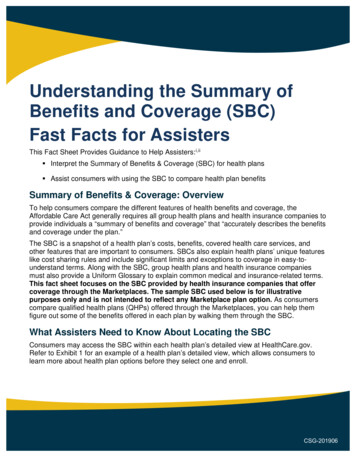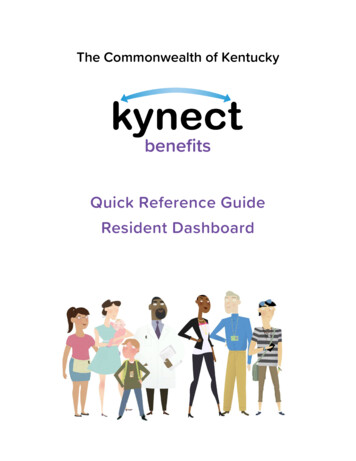
Transcription
Understanding the Summary ofBenefits and Coverage (SBC)Fast Facts for AssistersThis Fact Sheet Provides Guidance to Help Assisters: i,ii Interpret the Summary of Benefits & Coverage (SBC) for health plans Assist consumers with using the SBC to compare health plan benefitsSummary of Benefits & Coverage: OverviewTo help consumers compare the different features of health benefits and coverage, theAffordable Care Act generally requires all group health plans and health insurance companies toprovide individuals a “summary of benefits and coverage” that “accurately describes the benefitsand coverage under the plan.”The SBC is a snapshot of a health plan’s costs, benefits, covered health care services, andother features that are important to consumers. SBCs also explain health plans’ unique featureslike cost sharing rules and include significant limits and exceptions to coverage in easy-tounderstand terms. Along with the SBC, group health plans and health insurance companiesmust also provide a Uniform Glossary to explain common medical and insurance-related terms.This fact sheet focuses on the SBC provided by health insurance companies that offercoverage through the Marketplaces. The sample SBC used below is for illustrativepurposes only and is not intended to reflect any Marketplace plan option. As consumerscompare qualified health plans (QHPs) offered through the Marketplaces, you can help themfigure out some of the benefits offered in each plan by walking them through the SBC.What Assisters Need to Know About Locating the SBCConsumers may access the SBC within each health plan’s detailed view at HealthCare.gov.Refer to Exhibit 1 for an example of a health plan’s detailed view, which allows consumers tolearn more about health plan options before they select one and enroll.CSG-201906
Exhibit 1: Health Plan Details with SBCWhat Assisters Need to Know When Reviewing the SBC withConsumersAssisters should help consumers understand that all SBCs consist of the following basic parts: Important Questions: Consumers can use this section to understand some of the healthplan’s costs, including deductible amounts and out-of-pocket limits. This section alsocontains information on coverage for in-network and out-of-network providers. Common Medical Events: This section provides cost sharing information for certaincommon medical events (such as copayments and coinsurance amounts) and significantlimitations or exclusions. Services described include a visit to a provider’s office, havingan MRI or CAT scan, having a hospital stay, and prescription drug information. Excluded Services and Other Covered Services: Consumers can refer to this sectionto learn about certain services that are not covered by their health plan, as well as someadditional services the plan does cover.
Coverage Examples: All SBCs include examples of how a plan might cover ahypothetical consumer’s health care costs for sample health conditions, such aspregnancy or type 2 diabetes. Consumers should not use these coverage examples toestimate their actual costs under a plan because actual services and costs depend onconsumers’ individual medical needs when they consult with a provider. Instead,consumers should use the examples to get an idea of how much financial protection theplan is generally expected to provide for common health conditions. These standardized,hypothetical coverage examples can help consumers facilitate apples-to-applescomparisons between plans. Uniform Glossary: Each SBC contains a link to a glossary with consumer-friendlyexplanations of common medical and insurance terms, such as “deductibles” and“premiums.” All health insurance issuers use the same glossary. You can find theUniform Glossary online, here: https://www.healthcare.gov/sbc-glossary/.You should remind consumers that they can use the SBC to answer their general questionsabout a health plan before selecting a plan for enrollment. Consumers can contact the insurancecompany offering a plan for information about how it can help them pay for specific healthservices, and they should review the insurance policy closely. You should also remindconsumers that their benefits and coverage under a health plan may change during the benefityear, although this is not common, or when a new benefit year begins, which is very common. Ifinformation on a plan’s SBC changes in the middle of a benefit year, the health insurancecompany offering that plan must notify consumers of any changes at least 60 days before theygo into effect. Before a new benefit year begins, consumers should expect a new SBC from theirhealth insurance company that reflects any changes to their plan that will be in effect during thenew benefit year.Scenario: Using the Summary of Benefits to Help a ConsumerChoose a Health PlanElla, a 28-year-old consumer, wants to enroll in a health plan for herself and her husband for thefirst time. You help Ella submit a Marketplace application and she is determined eligible topurchase a QHP through the Marketplace. Ella has chronic back pain and her husband suffersfrom asthma, so she’s identified a QHP that she believes will provide good coverage for her andher husband’s conditions. However, Ella might need back surgery this year so she is concernedabout the plan’s prescription drug costs and any costs she may be responsible for if she visits aspecialist outside the plan’s network. You help Ella review the SBC to learn more about this planand she asks you following questions:
1. My last doctor said I might need to have in-patient back surgery in the next year. Do Ineed to get a referral to see a back specialist?First, direct Ella to the Important Questions chart of the SBC. One important question andanswer on this chart shows whether Ella would need a referral before she sees aspecialist. A sample Important Questions chart is displayed below in Exhibit 2.Exhibit 2: Sample Important Questions Chart2. If I do need surgery, how much will it cost me to have a surgery on this plan?You should inform Ella that the SBC cannot tell her the exact costs she will pay for acomplicated episode of care like back surgery. Her actual services and costs woulddepend on her particular medical needs, as determined in consultation with her provider.However, you can show Ella two sections of the SBC that will help her understandpotential cost-sharing amounts for services she will receive if she gets back surgery.
First, direct Ella to the Important Questions chart of the SBC. Explain that Ella must meetthe deductible amount in the first row before the insurance company would begin to payfor covered services. In this example, the plan has a 500 per person overall deductibleand a 300 specific deductible for prescription drug coverage.Next, direct Ella to the Common Medical Events chart shown in Exhibit 3 below. Thischart starts on the next page of the SBC and shows the potential cost-sharing amountsElla might be responsible for if she received various health care services after meetingthe plan’s deductible(s). For example, an office visit with a specialist in the plan’s networkhas a 50 copayment per visit for a participating provider, which means Ella would needto pay 50 each time she visits an in-network (participating) specialist. If Ella went to anonparticipating provider outside this plan’s network, she would have to pay 40 percentcoinsurance, or 40 percent of the allowed amount for the visit. For example, if the plan’sallowed amount for an out-of-network (nonparticipating) specialist visit is 200, hercoinsurance payment of 40 percent would be 80. This amount assumes that she hasmet her deductible. Also, if the out-of-network specialist’s charge is more than the plan’sallowed amount, the provider may charge her for the difference between the provider’scharge and the plan’s allowed amount (sometimes called “balance billing”). For example,if the specialist’s charge was 250 in the example above, Ella could have to pay 50( 250 specialist charge minus 200 plan allowed amount), plus the 80 coinsurance, fora total cost of 130. This is why is it often beneficial for enrollees to look for in-networkproviders, where out-of-pocket costs are typically lower.Ella should also pay attention to the “If you have a test” row of the Common MedicalEvent chart to determine the potential cost sharing for having an imaging test performed,like an MRI or CT/PET scan. Ella can find other services she may need, in the CommonMedical Event chart as well, including “If you have outpatient surgery” and “If you have ahospital stay.” Either of these rows may apply, depending on whether her surgery wouldbe performed in an outpatient or inpatient setting.
Exhibit 3: Sample Page from Common Medical Events ChartFor the most accurate information about specific services Ella is interested in, she canuse the contact information at the top of the first page of the SBC to contact the plan’sissuer and request a copy of the actual plan or policy document. This document providesdetailed information about specific benefits covered under a plan. Refer to Exhibit 4.
Exhibit 4: Sample Contact Information for More Details about Coverage3. All these services and costs seem to be adding up quickly! Does this plan offer anyprotection for me if I have to pay a lot out-of-pocket in one coverage year?To answer this question, return to page 1, shown in Exhibit 2, and find the row for “Whatis the out-of-pocket limit for this plan?” The out-of-pocket limit, as explained in theUniform Glossary, is the most Ella could pay during a policy period (usually a year)before her health insurance company begins to pay 100 percent of the allowed amount.In this example, if Ella spends over 2,500 for services from in-network (or participating)providers, the health insurance company will begin to pay 100 percent of the allowedamount. As this plan’s SBC shows, the out-of-pocket limit never includes premiums,balance-billed charges 1, or health care the health insurance company doesn’t cover.Additionally, some health insurance companies don’t count all copayments, deductibles,coinsurance payments, out-of-network payments, or other expenses toward this limit.4. Thanks! Now that I know how to interpret the cost sharing features of a plan using theSBC, maybe I should look at another SBC to see how this plan matches up to anotherplan I was considering earlier.Tell Ella that using the SBC to make apples-to-apples comparisons easier is exactly oneof the main purposes of the SBC. If she doesn’t have ready access to the other SBC, shecan always request it from the insurance company, which must send it within sevenbusiness days.Additional ResourcesFor more information visit: CMS: Summary of Benefits and CoverageAvailable at: s-and-Coverage-and-Uniform-Glossary.html1For a definition of balance billing, go to: illing.
HealthCare.gov: Overview of Summary of Benefits and CoverageAvailable at: e-law-protectme/summary-of-benefits-and-coverage/ Marketplace.cms.gov: A presentation on the Summary of Benefits and CoverageAvailable at: pdf.iThe information provided in this document is not intended to take the place of the statutes, regulations, and formalpolicy guidance that it is based upon. Links to certain source documents have been provided for your reference.We encourage all assisters to refer to the applicable statutes, regulations, and other interpretive materials forcomplete and current information.iiThis communication was printed, published, or produced and disseminated at U.S. taxpayer expense.
Interpret the Summary of Benefits & Coverage (SBC) for health plans Assist consumers with using the SBC to compare health plan benefits. Summary of Benefits & Coverage: Overview . . depend on her particular medical needs, as determined in consultation with her provider. However, you can show Ella two sections of the SBC that will help her .










